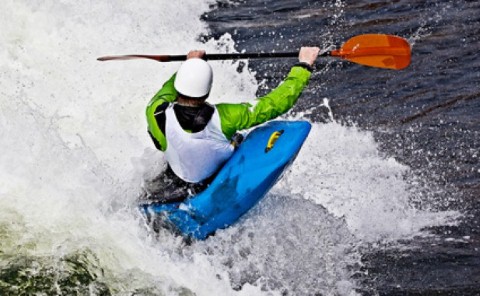 One of the great things about the sport of kayaking is its simplicity. All that is needed to get on the water is a kayak, paddle, personal flotation device (PFD) and a sprayskirt for paddling a sit-in boat. However, when venturing into whitewater or any briskly flowing stream, and certainly in surf, there is one more item that is absolutely essential: a good helmet. As far as whitewater goes, even someone who has never lifted a paddle can watch kayakers running rapids and realize that a helmet is in no way optional. In most whitewater conditions, banging against rocks can be considered part of the sport. And regarding wave riding in a kayak, even when paddling off a beach, you would be surprised how hard sand can be when hit head first.
One of the great things about the sport of kayaking is its simplicity. All that is needed to get on the water is a kayak, paddle, personal flotation device (PFD) and a sprayskirt for paddling a sit-in boat. However, when venturing into whitewater or any briskly flowing stream, and certainly in surf, there is one more item that is absolutely essential: a good helmet. As far as whitewater goes, even someone who has never lifted a paddle can watch kayakers running rapids and realize that a helmet is in no way optional. In most whitewater conditions, banging against rocks can be considered part of the sport. And regarding wave riding in a kayak, even when paddling off a beach, you would be surprised how hard sand can be when hit head first.
Anatomy of a Life-Saver
A kayak helmet has three main components. The hard outer shell gives the helmet its shape and comes between your soft head and the hard outer world. The lining is the foam padding inside the helmet that molds to the paddler’s head and provides for a snug, comfortable fit. The strap system keeps the helmet in place while water is rushing over and through it as your head drags on the bottom of the river. Modern helmets come in two basic types. Full-cut helmets extend down to protect the ear and temple. Half-cut helmets sit above the ear like a baseball cap. They are usually looser-fitting, lighter weight and more comfortable than full-cut helmets, and are the most commonly used nowadays.
Choosing a Helmet
The first thing to consider is what type of shell material you would like. Look for Kevlar, carbon fiber and composite polymer for the hardest, strongest and lightest whitewater helmets. These materials are also the most expensive. Plastic helmets have the lowest strength, but they have been used and proven for decades in whitewater and are very affordable. The next step is deciding on full- or half-cut design. Many people like the half-cuts that have a small baseball cap style brim. If you will be paddling mostly in shallow, rocky conditions, a full-cut gives a more secure, protected feel. Full-cut helmets can also add a bit of warmth in cold conditions.
Find the Fit
Try on helmets to find a shell that fits the size and shape of your head. Different brands vary in this respect. The padding should feel snug and cushiony with no pressure points or pinching. The liner should be slightly depressed where it contacts the head, with no gaps between head and liner. The helmet should not be too tight or it will give you a headache or painful pressure spots with hours of wear. On the other hand, once the straps are adjusted and buckled, the helmet should not wobble or shift much. Remember that being under moving water in particular positions will cause water to enter the helmet and put some force on it, as you definitely do not want it to come off!

